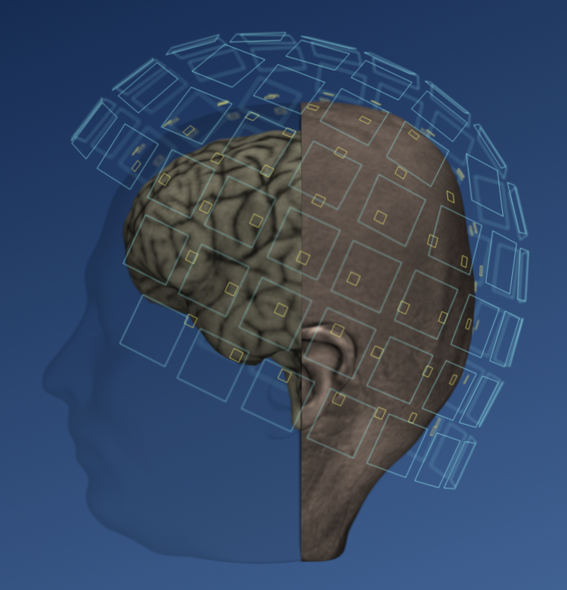Novel technology allows more accurate measurement of brain activity

Aalto University researchers are designing a brain-imaging device that uses a new type of sensor placed on the surface of a person’s head. The new sensors employ quantum optics, allowing them to reduce the distance between the brain surface and the sensors to half of what current magnetoencephalography (MEG) scanners use.
MEG allows researchers to see which parts of the brain are active by measuring the magnetic fields produced by electric currents in the brain. Currently, MEG scanners use superconducting sensors which need to be extremely low temperatures (just few degrees above absolute zero) to function. To keep them ultra-cold, the sensors require liquid helium, which makes MEG scanners large and expensive. To protect the patient’s head from the extreme cold, the sensors need to be thermally insulated keeping them at least 2 cm away from the head.
‘When the distance between the brain and the nearest sensor grows, the magnetic field decays and the accuracy of localising brain activity weakens. Sensors in MEG devices on the market today do not adapt to the head shape of the person being scanned: the same large sensor helmet is used both on adults and newborn babies’, says Professor Lauri Parkkonen.
Parkkonen explains the benefits of their new sensors, ‘They are small, can function in room temperature, be placed directly on the head of the study subject, and the measurement accuracy is approaching that of measurements done inside the skull in patients’ Parkkonen says.
In a recent study, these on-scalp magnetic field sensors were compared to the superconducting sensors of a MEG scanner in current use. The study was carried out by showing the test subjects images that activate the visual cortex and by using both methods to measure the brain responses. The brain signals measured with the on-scalp sensors were larger and, on average, of better quality, as a result of the shorter measuring distance. The study also indicated that with the new sensors it was possible to reliably localize the activated brain areas.
‘The new sensors were better at recording high-frequency brain responses, which reflect local brain activity’ says doctoral candidate Rasmus Zetter.
The recently published study utilises the group's earlier results which include research assessing the strength of brain signals between different measuring methods by using simulations carried out on anatomically realistic head models. According to the studies, the localisation and separation of simultaneously active brain areas became more accurate. Additionally, the group has developed a method to precisely determine the locations of the new sensors in relation to the head and brain in every measurement enabling the localization of the activated brain areas.
‘As the measurement distance to the brain decreases, brain signals get stronger. When measured more closely, the magnetic field is also more detailed so that the localisation of the activated brain areas is more accurate’, says doctoral candidate Joonas Iivanainen.
The study is primarily funded by the European Research Council (ERC), and Parkkonen’s team is also involved in the European Union’s billion-euro Quantum Flagship project macQsimal, where these sensors are developed further.
‘At the moment, the sensors are not sufficiently stable or sensitive enough, and they also interfere with each other if placed too close together. Furthermore, the sensors are handcrafted, which is expensive’, Parkkonen describes.
However, he is confident of overcoming these hurdles, as technology is developing at a tremendous pace, ‘Small MEG measuring devices partially covering the head may be produced fairly soon. It will, however, take years before it’s possible to produce a device covering the whole head, with its hundreds of magnetic field sensors working reliably.’
The new measuring devices may be particularly useful in the planning of epilepsy care, especially in localising the epileptogenic regions in the brain before surgery, ‘The new sensor system makes it possible to detect more accurately where in the brain the epileptic activity starts, and in which kind of a network it spreads’, Parkkonen says.
Further information:
Lauri Parkkonen
Professor
Aalto University
[email protected]
tel. +358 (0)40 508 9712
Joonas Iivanainen
Doctoral Candidate
Aalto University
[email protected]
Rasmus Zetter
Doctoral Candidate
Aalto University
[email protected]
Article: Potential of on‐scalp MEG: Robust detection of human visual gamma‐band responses https://onlinelibrary.wiley.com/doi/10.1002/hbm.24795
MacQsimal project developing extremely precise sensing technology: Miniature Atomic Vapor-Cells Quantum Devices for Sensing and Metrology Applications https://www.macqsimal.eu/
Earlier articles:
A simulation of the relationship between signal and noise, and localisation accuracy https://doi.org/10.1016/j.neuroimage.2016.12.048
A simulation of the necessary accuracy of sensor placing https://doi.org/10.1007/s10548-018-0656-5
Implementing sensor localisation with an optical 3D scanner https://doi.org/10.1038/s41598-019-41763-4
A general technical description of the on-scalp MEG system and a description of the implementation of active shielding against interference https://doi.org/10.1016/j.neuroimage.2019.03.022
- Published:
- Updated:
Read more news

Aalto EE Introduces Alex: A New Learning Experience Platform to Transform Lifewide Learning and Tackle Upskilling Challenges
Aalto University Executive Education (Aalto EE) is launching the first version of Alex in June, a learning platform designed to enhance continuous professional development. Alex offers personalized learning journeys, micro-credentials, and professional development programs, aligning current skills with industry needs. This platform, which continuously evolves with new features like mobile access and AI integration, sets a new standard for professional development in Finland.
Just believing that an AI is helping boosts your performance
People perform better if they think they have an AI assistant – even when they’ve been told it’s unreliable and won’t help them
Viktar Asadchy receives Young Scientist Award
The Finnish Foundation for Technology Promotion awarded Assistant Professor Viktar Asadchy with the Young Scientist 2024 Award.